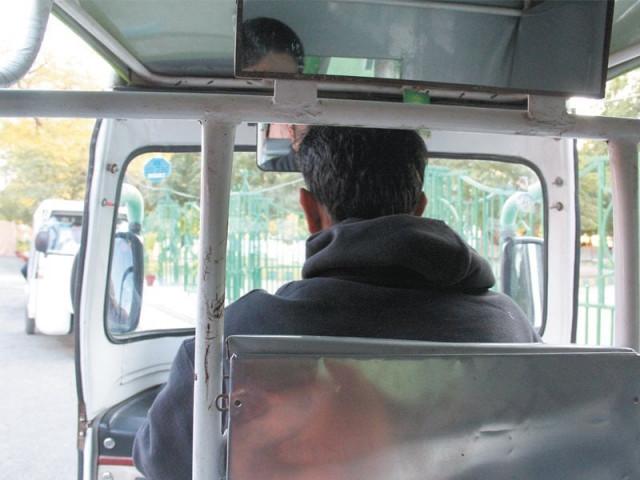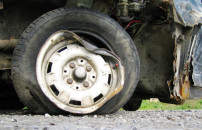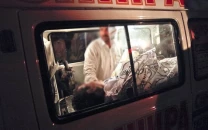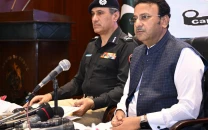Democratic streets: Is moving faster more important than culture?
A city that suits itself to those living in it is better than one that spends to attract them.

Nowpdp’s user-friendly, rickshaw-to-your-doorstep service run entirely by people with disabilities. They were ferrying. PHOTO: AYESHA MIR/EXPRESS, people around at the South Asian Cities conference at Frere Hall from January 10 to 12.
When Karen Armstrong was asked to define a ‘compassionate city’, her response struck the audience as quite odd. “A compassionate city is a profoundly uncomfortable city - one that is not self-satisfied,” she had remarked thoughtfully.
Her colleague, Dr Andrew Charles Himes of the Charter for Compassion, explained the essence of her response at a seminar on the third day of the South Asian Cities Conference here Sunday. “A compassionate city is one that is uncomfortable with the knowledge that a lone man sleeps on the sidewalk that night - or if a child goes to bed hungry - or if a handicapped person does not get the opportunity to fulfill his dreams,” he explained.

The Charter for Compassion is a document designed around the Golden Rule: “Do unto others what you would have them do unto you.” The movement aims to instill compassionate thinking and action at the centre of religious, political and moral values. “Islam is one religion [in which] compassion lies at the very centre of the doctrine,” said Dr Himes. It is perhaps this very reason that the movement caught on rapidly in Islamic countries, with Pakistan becoming one of the first signatories to the charter after it was promulgated by the United Nations in 2009.
“So how do you make a city compassionate?” he asked rhetorically. “You start at the roots - you start at the school level.” The organisation’s activities in Pakistan include signing up schools to the charter. The schools subsequently include and reinforce values of compassion among the youth.
A compassionate city, according to him, is one that works well for everyone - the women, children, handicapped or those with lesser means. It allows all its citizens to contribute something unique to its makeup, no matter how small or insignificant the contribution may seem. “It is the feeling of being a part of something bigger that makes everyone own the city,” he said.
His fellow panelist, Ahmad Rafay Alam, agreed. A lawyer by profession, Alam has been actively involved in shaping the urban policies of his historic city in the recent years. He described his experiences of being a part of the ‘Lahore Bachao’ project - a movement started by a group of civil activists in 2006 that challenged the government’s plans to reshape the urban landscape of the city. The catalyst to the movement was the Punjab government’s plans to widen the canal road. This was unacceptable to the group for many reasons.
“It is a misconception that widening roads helps smooth[en] traffic flow,” he asserted. The project, if launched would have meant razing almost 8,000 trees.

When the matter was taken up by the Supreme Court in 2009, the authorities maintained that the construction would help ease the flow of traffic. The petitioners, meanwhile, had other ideas. “The construction would have been detrimental to the built and shared heritage that gives Lahore its distinctive feel,” said Alam. “It would have destroyed the essence of what the residents identify as their city.”
Alam and his peers argued that the project would only cater to the eight per cent of residents who owned cars. “Almost 40% of Lahoris walk to work,” he said. “It would therefore be an injustice to them to modify their surroundings to appease the eight per cent who lived at the city’s outskirts.”
In his address on Sunday, Alam quoted a study that found that 9.6 million trips were made in a day by the people of Lahore. For a city of almost 10 million, the figure was alarmingly low.
“The basic problem lies in the lack of mobility - that is, for the women, children, the aged and the handicapped,” he explained. “How can a city retain its lively culture if the citizens cannot move about freely?”

It is the fundamental right of each person to move freely as they choose. “Any urban infrastructure that obstructs that right is a violation of the law,” he remarked. “Even the BRT in Lahore does not respect that right,” he said, adding that the system, in all its grand design, did not give way for cyclists or those wishing to use other means to make their journey.
For Alam, the best city in the world can be described in the words of Enrique Peñalosa, the former mayor of Bogota, Columbia, who brought it BRTS, TransMileneo: “A city that is good for children, the elderly, the handicapped, the poor, is good for everyone else.”
Alam believes democracy exists in the streets, not the ballot box. A ‘democratic street’ is one that allows people the freedom to be mobile and choose the mode of transport best suitable to them - be it cycling, walking or driving. “When planning these projects for roads and mass transit systems, what the authorities fail to address is the need to respect that very fundamental right to mobility,” he said. “It is the sidewalk where intellectual giants rub shoulders with each other. It is these spaces where history is written and culture is defined.” It is lamentable that our planners would rather enable us to move faster than retain our culture.
He summed up his address with a prescription: “The city that suits itself to people living in it is likely to progress better than the city that spends huge amounts to attract people.”
Archaeologist Dr Kaleemullah Lashari was the last of the panellists to present. Dr Lashari chose to recount the ‘Culture and social life of Karachi as reflected through Hotel Metropole’.
For Dr Lashari, the Hotel Metropole was a symbol of the liveliness and vibrancy that defined Karachi in the early years. The grand structure was a testament to the times when foreign dignitaries and the elite convened at grand events at the hotel. From Eid galas to concerts featuring popular foreign musicians, the hotel catered to everyone’s taste.
It is these very features that have made Hotel Metropole an important landmark on the city’s map - one that is easily identifiable by the poor and elite alike.
Published in The Express Tribune, January 13th, 2014.



















COMMENTS
Comments are moderated and generally will be posted if they are on-topic and not abusive.
For more information, please see our Comments FAQ